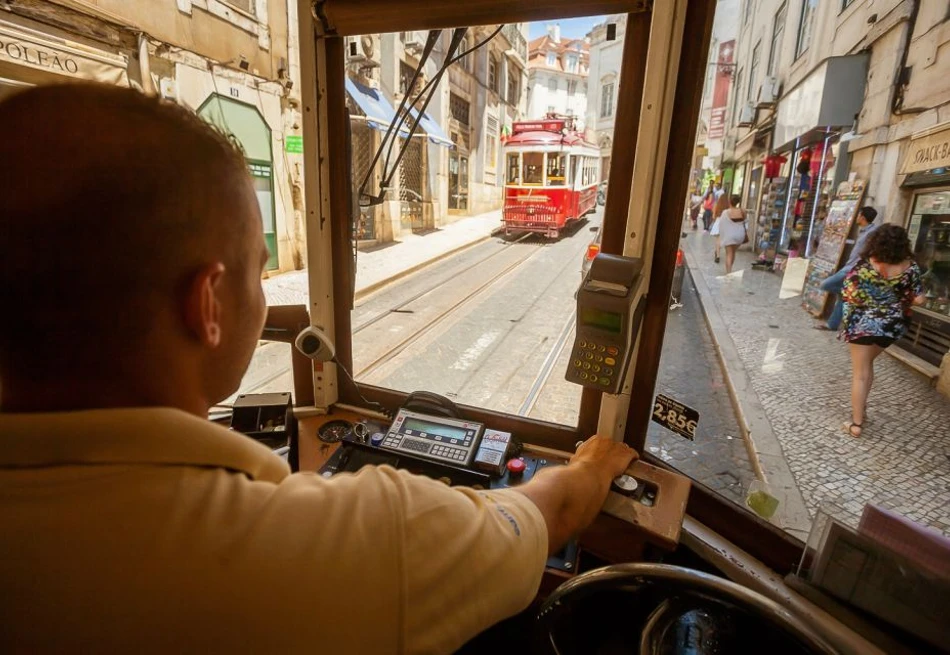
Lisbon’s Tram 28, which was inaugurated more than 110 years ago — has a long and chequered history.
Every year, around four million tourists board Tram 28 and enjoy the experience.
The history of these Lisbon trams dates back to the late 19th century when horses were used as a means of transport in what can be called the very first version of tramline transport in Portugal.
Today, the tramline system is one of the iconic forms of transportation in the city.
Here, we tell you how Portugal built its tramline system over the years and what made the Tram 28 ride one of the most popular tourist experiences.
Early days of Lisbon’s Tram 28

The tramline system began in Lisbon as a horsecar line service in 1873.
They are called ‘Americanos’ because the idea of using horses as a mode of transport originated in the US.
However, there was a problem!
The horses couldn’t reach steep slopes, and the industry experts introduced funiculars in 1884 to tackle this issue.
The funicular system was quite successful for the next 15 years until the electric trams took over its place in 1901.
Carris Co., a Brazilian company, imported a tram system from the US, and Lisbon’s transportation mode took a huge leap from then on.
Why is Lisbon Tram 28 famous?
Tram 28, introduced in 1914, is a widely used public transport and tourist experience.
The routes and services of Tram 28 have been gradually updated and modified over the century-long years of service.
Even today, around 50 wood trams run to and from Tram 28’s routes. It can accommodate up to 20 sitting and 38 standing passengers.
They start from Martim Moniz to Campo Ourique and vice versa.
Tram 28 is popular because it lets you see popular attractions, including Alfama, Rossio, Praca do Comércio, and Graça.
You can see the mix of traditional and modern life in Alfama – one of the oldest districts in Lisbon.
Experience the panoramic views of the city at Santa Justa Lift in Rossio.
Explore Praca do Comércio, the city’s majestic square, and shop or try some delicious foods there.
Other highlights include the Equestrian Statue, Miradouro de São Pedro de Alcântara, and Cais do Sodré.
Witness the hilltop, bargain at Feira da Ladra Flea Market, or try local cuisines in Graça.
While these are the attractions of Lisbon, a ride on Tram 28 gives you a sense of witnessing all these places in one go, which makes it special.
Recommended Reading: Tram 28 Lisbon Alternatives
Red vs Yellow Tram 28

After the Yellow Tram 28 became popular with tourists because of its scenic route, the city of Lisbon decided to introduce the Red Tram 28.
This Red Tram 28 caters exclusively to tourists, but visitors still prefer the Yellow Tram 28.
The city has two types of trams—red and yellow trams—apart from the tourist red Tram 28.
Red trams, modernized and called ‘Articulado, ‘ are spacious compared to yellow trams and are used in the city’s flat regions.
The traditional yellow trams, known as ‘Remodelado,’ run through the narrow streets of Lisbon. Tram 28 is the most famous yellow tram.
If you wish to travel with regular local passengers and enjoy a sense of neighborhood, you can opt for Lisbon Tram Ride 28 and Walking tour, which costs €20.
While tourists can opt for rides on the yellow tram, the special Red Tram 28 allows them to enjoy the ride with less crowd. The Red Tram 28 tour ticket costs €25.
These vintage trams are still in use despite the advanced developments of the metro lines and buses in the city.
Knowing these details about trams in Lisbon will help you pick a better Tram 28 ride based on your time, budget, and preferences.
Looking for a Tram 28 alternative?
Take a private tour of Tram 28 routes in a tuk-tuk (auto). This 105-minute ride gives you the exact essence of traveling a tram 28. This is the perfect tour if you don’t like a crowded bus, have limited time, and can’t afford to spend time in the queue. Or just stick to the traditional Tram 28 ride which offers a nostalgic experience.
Can I purchase Lisbon Tram 28 tickets offline?
Yes, you can buy Tram 28 tickets offline. However, we suggest you buy tickets online to avoid last-minute disappointments.
If you want to spend more time on the Tram 28 route, you can purchase a Red Tram 28 ticket or Yellow Tram 28 ticket.
Or get the Tram No. 28 with a walking tour ticket to experience the Tram No. 28 ride along with a walking tour in the Alfama district.
What is the best time to take the Tram 28 ride?
Tram 28 is a popular tourist experience, and locals use them on a daily basis. Hence, it is crowded most of the time.
The best time to take the ride is early morning when it starts from Mortim Montiz around 6 am.
You can take the Tram 28 ride after peak evening hours (after 8 pm).
Is it safe to take the Tram 28 ride?
Yes, it’s safe to take the Tram 28 ride. It is adventurous, passing through Lisbon’s narrow streets and steep hills.
However, you need to take care of your belongings and wallets, as pickpocketing is common on Trams in the city.
How long is the Tram 28 ride?
It takes around 50 to 60 minutes for a complete Tram 28 journey.
Can I take photos and videos while riding on the Tram 28 in Lisbon?
Yes, you can take photographs and videographs while passing through picturesque city views.
However, please take extra care of your equipment as the tram moves across narrow streets and hills.
Are kids allowed on the Tram 28?
Yes, children are allowed to take the Tram 28 ride. However, at least one adult should accompany them.
Is there any alternative to explore the Tram 28 route?
Yes, The Private Tour on Tram 28 route gives you a personalised experience of taking the historic route and exploring Lisbon’s iconic landmarks such as Largo das Portas do Sol, Sé Cathedral, and Basílica da Estrela. It costs €129 for a group of three.
